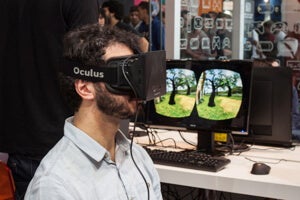Stanford Virtual Reality Lab Ditches $40K Rig for $350 Oculus Rift

Share
Ever since the Oculus Rift first started blowing minds a few years ago, virtual reality hasn’t just been a hot topic, it’s inspired a $2 billion Facebook acquisition and a mob of competitors. Immersive VR film was featured at the Sundance film festival, and GoPro just acquired a VR startup to complement its cameras.
But this isn’t virtual reality’s first trip around the block. It’s an old idea and the road behind is scattered with the bodies of failed tech. Is the excitement justified? We think yes. Here’s why: The experience you get with today’s technology is better than state-of-the-art was just a few years ago—at a fraction of the cost.
How do we know?
Sometimes a single line in an article can make the rest of the story just sort of melt away. In a great piece about Jeremy Bailenson’s Virtual Human Interaction Lab at Stanford, the author casually drops this tidbit:
“…[Bailenson is] thrilled by the recent surge of VR technological innovation that has allowed his lab to now replace its older $40,000 headset with a $350 Oculus Rift DK2 headset.” (Our underscore.)
The article calls Bailenson a VR pioneer, his lab attracting visits from heads of state, the military, and NASA over a two decades. His site lists some 100 research papers. The Stanford lab specializes in the social implications of VR but has also worked on new ways to improve VR simulations (e.g., gesture tracking and 3D modeling). In short, Bailenson’s lab is on the front lines of VR research.
And for the finely tuned tastes of a VR veteran and stringent requirements of a lab setting? These can be satisfied by a headset (still in development, mind you) that is over 100 times cheaper than its predecessors.
Be Part of the Future
Sign up to receive top stories about groundbreaking technologies and visionary thinkers from SingularityHub.


This fact, combined with (and inspiring) today’s rush into the space, is why VR is likely to move quickly in the future. That isn’t to say there aren’t still challenges—like body tracking and effective VR controllers, to name two—but the rush of investment and passion is a little reminiscent of the early days of the PC.
And equally promising are the prospects for VR's sister technology, augmented reality, in which the digital realm is laid over the real world to create a hybrid. The sensors and computing power driving VR underpin AR too, though they part ways in how images are displayed. Microsoft's HoloLens continues to drum up excitement, as the more mysterious Magic Leap ploughs ahead with nearly $600 million in funding.
More dollars, minds, and creativity may rapidly break new ground. “I’ve seen more technological change in the last eight months than I have in [the last] 19 years combined,” Bailenson told IEEE Spectrum.
To our readers: Beyond entertainment, what are the most intriguing VR (and AR) applications? What are the greatest remaining technical challenges? Who will make the first must-have, mass market machine—and, perhaps more importantly, when will it be available?
Image Credit: Shutterstock.com
Jason is editorial director at SingularityHub. He researched and wrote about finance and economics before moving on to science and technology. He's curious about pretty much everything, but especially loves learning about and sharing big ideas and advances in artificial intelligence, computing, robotics, biotech, neuroscience, and space.
Related Articles

This Portable Wind Turbine Is the Size of a Water Bottle and Charges Devices in Under an Hour

Mojo Vision’s New Contact Lens Brings Seamless Augmented Reality a Step Closer
The Weird, the Wacky, the Just Plain Cool: Best of CES 2020
What we’re reading

